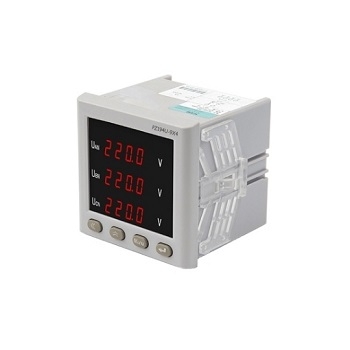Digital Panel Meters, often referred to as DPMs, are electronic devices used to measure and display various electrical or physical parameters on a digital screen. These meters are commonly found on control panels, instrumentation panels, and in various industrial, commercial, and scientific applications. Digital Panel Meters offer several advantages over traditional analog meters, such as improved accuracy, readability, and the ability to easily interface with digital control systems.
Key Features and Uses
- Digital Display
DPMs feature a digital screen that provides a numerical readout of the measured parameter. This makes it easier to read and interpret values compared to analog needle-based meters. - Versatility
Digital Panel Meters can measure a wide range of parameters, including voltage, current, resistance, temperature, frequency, pressure, flow, and more. Some DPMs are specialized for specific parameters, while others offer more general measurement capabilities. - Accuracy
Digital meters are known for their high accuracy and precision. They provide reliable and consistent readings, making them suitable for applications where precision is crucial. - Easy Calibration
Many DPMs can be calibrated or adjusted to maintain accuracy over time, ensuring that they continue to provide reliable measurements. - Customization
Some DPMs allow users to customize the display units, scaling, and other settings to match the specific needs of their application. - Analog and Digital Inputs
Some DPMs accept both analog and digital input signals, allowing them to be compatible with a wide range of sensors and transducers. - Communication Options
Advanced DPMs may offer communication options such as RS-232, RS-485, or Ethernet, enabling data logging and remote monitoring. - Panel Mounting
DPMs are designed for easy panel mounting, making them suitable for integration into control panels and industrial equipment. - Compact Design
DPMs are often compact and space-efficient, making them ideal for applications with limited panel space. - Industrial and Commercial Use
Digital Panel Meters find applications in a variety of industries, including manufacturing, energy, HVAC, automotive, and laboratory settings, where precise measurements and monitoring are essential.
Instructions For Use
- Safety Precautions
Before you begin, ensure that the electrical circuit is de-energized and safe to work on.
If you are not familiar with electrical circuits, it's advisable to seek help from a qualified electrician or technician. - Installation
Mount the DPM securely on the control panel or the designated location.
Make sure the power supply (voltage and current) to the DPM is within the specified range mentioned in the meter's technical specifications. - Power On
Connect the power supply to the DPM as per the manufacturer's guidelines.
Turn on the power source to the DPM. - Initial Setup
If your DPM has adjustable settings (such as scaling, units, or communication options), consult the user manual to configure it according to your specific needs.
Ensure that the meter is set up to measure the parameter of interest (e.g., voltage, current, temperature). - Measurement
Once powered on and configured, the DPM will start displaying the measured parameter on the digital screen.
Read and interpret the numerical value shown on the display. Make sure you understand the units of measurement. - Calibration (If Required)
Some DPMs may require periodic calibration to maintain accuracy. Check the user manual for calibration instructions and frequency.
Calibrate the meter using appropriate calibration equipment or follow the manufacturer's recommendations. - Data Logging and Communication (If Applicable)
If your DPM offers data logging or communication features, configure and use these options as needed, following the user manual or instructions provided by the manufacturer. - Maintenance
Regularly inspect the DPM for any physical damage or signs of wear.
Keep the display clean and free of debris or dust, which can affect readability.
Check for loose connections or wires. - Troubleshooting
If you encounter issues with the DPM's performance, refer to the troubleshooting section of the user manual for guidance.
If problems persist, contact the manufacturer's technical support or consult a qualified technician. - Power Off
When you're done using the DPM, turn off the power source.
Ensure the DPM is disconnected from any live electrical circuits before maintenance or further adjustments.
Overall, Digital Panel Meters have become an integral part of modern control and measurement systems, offering improved accuracy, ease of use, and flexibility in various industrial and scientific settings. sisco.com offers high-quality digital panel meters, click to shop if you are interested.

